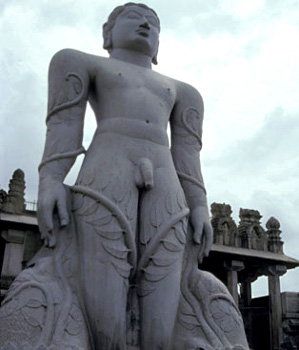 Idol worship among Jains is not common among all sections of Jains. The Digambaras worship idols of Jain Tirthankaras. The Swetambaras too worship the images of Tirthankaras. The priest before entering the temple for his morning Puja dons pure Puja-clothes of high-quality cloth. As he crosses the threshold, he utters the word `nisihi` three times signifying that he is leaving behind all worldly things and will think only of God only. He proceeds to the door into the gabharo wherein the images are enshrined. A Jina Murti is basically a carved stone representation of a Jina who is seated in eternal meditation.
Idol worship among Jains is not common among all sections of Jains. The Digambaras worship idols of Jain Tirthankaras. The Swetambaras too worship the images of Tirthankaras. The priest before entering the temple for his morning Puja dons pure Puja-clothes of high-quality cloth. As he crosses the threshold, he utters the word `nisihi` three times signifying that he is leaving behind all worldly things and will think only of God only. He proceeds to the door into the gabharo wherein the images are enshrined. A Jina Murti is basically a carved stone representation of a Jina who is seated in eternal meditation.
Standing in front of the gabharo the worshipper silently receives Darshan of the Jina. The worshipper then thrice circumambulates the gabharo keeping in mind three Jewels of Right Faith, Right Knowledge and Right Conduct that lead to release from the rounds of rebirth. He sings a hymn of praise too at that time. The worshipper now prepares for an elaborate Puja. Some sandalwood and saffron water is mixed in a small metal bowl. He ties his mouth with the cloth with a handkerchief that covers his mouth so that while performing the Puja he does not commit violence. Ahimsa is the central Jain ethical precept and all aspects of Puja must be performed in accordance with this principle.
The worshipper now holds aloft a mirror and performs Kesar Puja by dabbing sandalwood paste onto the reflected image of the mul nayak. He enters the gabharo bows his head to the feet of the Jina before commencing the eightfold Puja. In the centre of the temple, he begins the eightfold Puja. The image is cleaned with water and milk. This is the first Puja. Using the ring finger of his right hand, he performs the nine-limbed sandalwood-saffron Puja to the main image. Thereafter the third Puja is performed which is done by adorning the image with flowers. The rest of the five pujas are collectively known as the agra Puja, or `facing puja`. The first two agra pujas are performed when he is in the gabharo. He performs incense puja. Thereafter he proceeds to his mental worship or bhav puja.
Each of the eight offerings has a symbolic meaning. The sandalwood Puja symbolizes the cooling of the passions and the fruit symbolizes liberation. The offerings are to the virtues of enlightenment, liberation, and dispassion which is signified by the Murti. The Puja performed by the Jain layman is called Dravya Puja.




















